Jackson M.J. Micro and Nanomanufacturing
Подождите немного. Документ загружается.

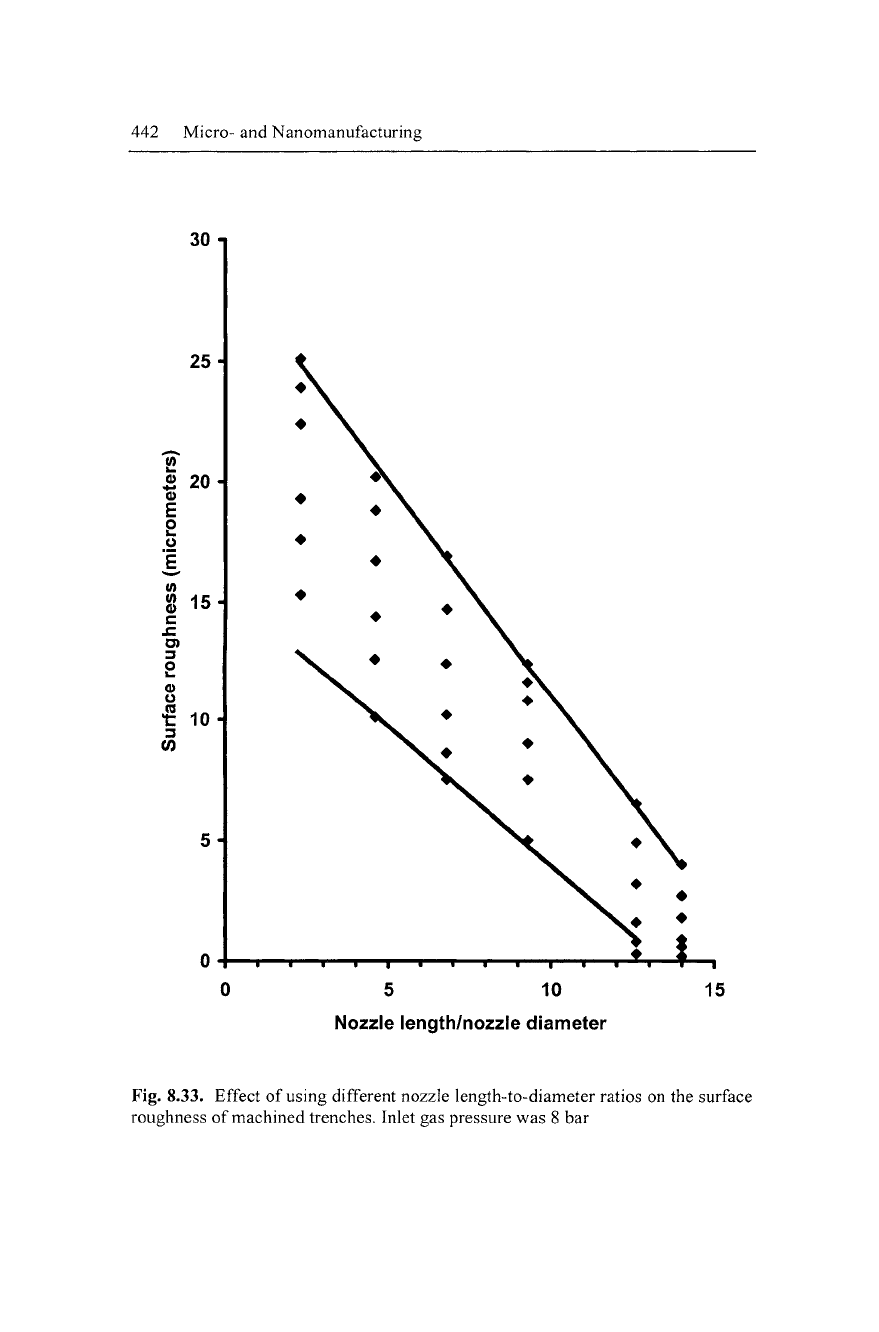
442 Micro- and Nanomanufacturing
30 1
25 H
2
£ 20
E
o
o
1
8 15
c
O)
3
s
CD
O
•S 10
3
(0
5H
I I I I I I I I I I I I ^ I • I
5 10
Nozzle length/nozzle diameter
15
Fig. 8.33. Effect of using different nozzle length-to-diameter ratios on the surface
roughness of machined trenches. Inlet gas pressure was 8 bar
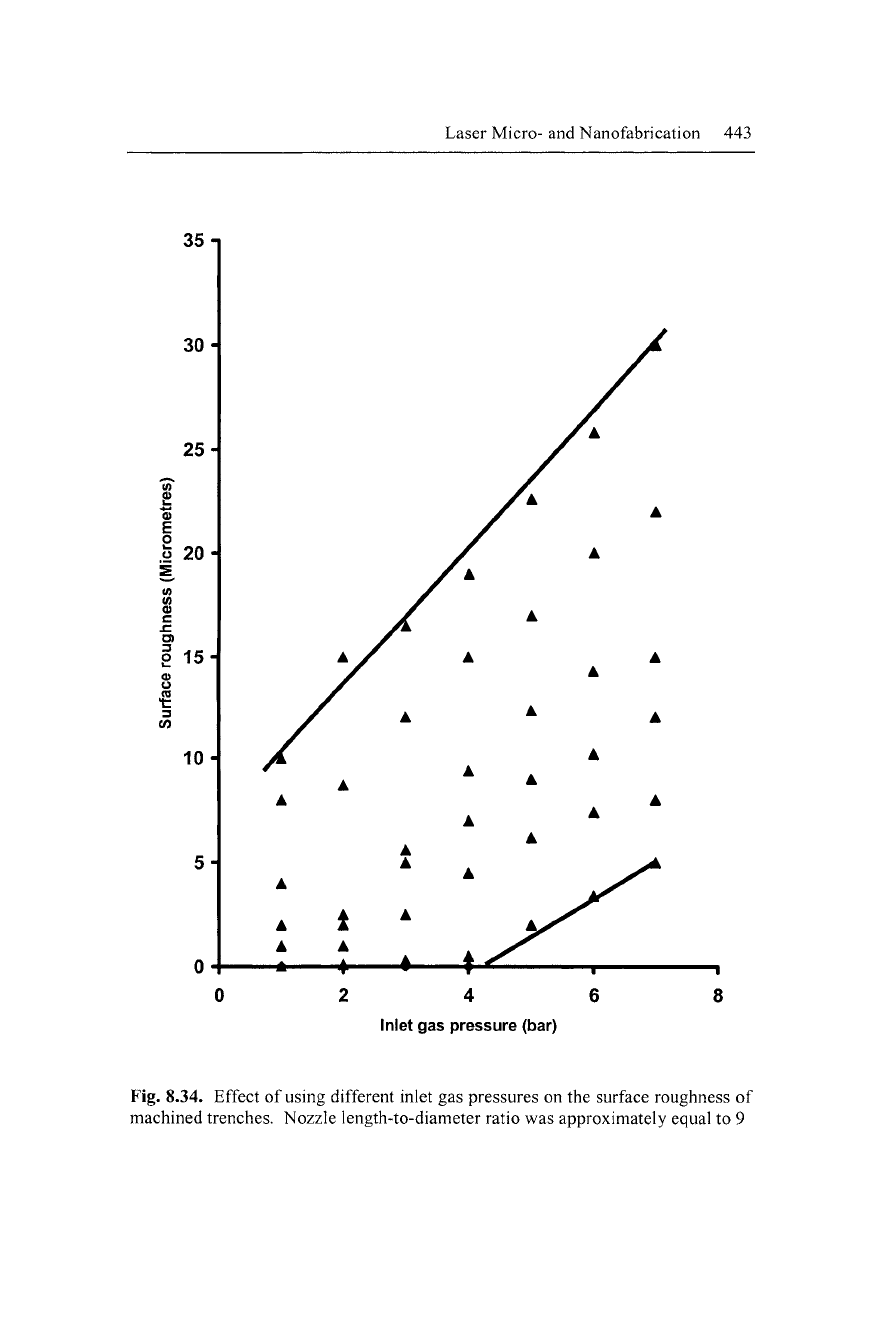
Laser Micro- and Nanofabrication 443
35 1
30 H
25 H
E
o
o 20
tn
V)
(D
c
O)
o 15
o
CO
10 H
5H
•
A
•
i
•
2 4 6
Inlet gas pressure (bar)
Fig. 8.34. Effect of using different inlet gas pressures on the surface roughness of
machined trenches. Nozzle length-to-diameter ratio was approximately equal to 9
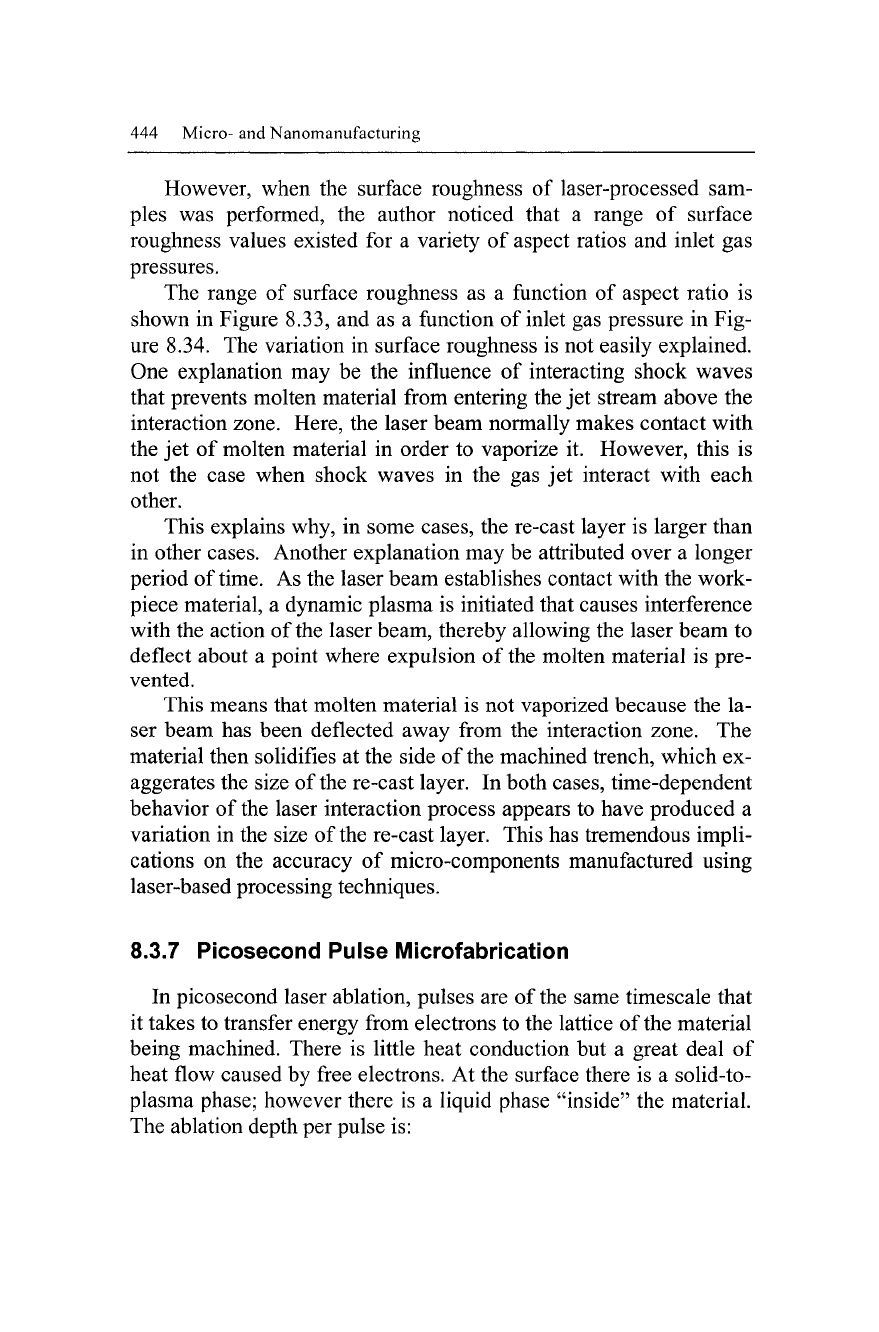
444 Micro- and Nanomanufacturing
However, when the surface roughness of laser-processed sam-
ples was performed, the author noticed that a range of surface
roughness values existed for a variety of aspect ratios and inlet gas
pressures.
The range of surface roughness as a function of aspect ratio is
shown in Figure 8.33, and as a function of inlet gas pressure in Fig-
ure 8.34. The variation in surface roughness is not easily explained.
One explanation may be the influence of interacting shock waves
that prevents molten material from entering the jet stream above the
interaction zone. Here, the laser beam normally makes contact with
the jet of molten material in order to vaporize it. However, this is
not the case when shock waves in the gas jet interact with each
other.
This explains why, in some cases, the re-cast layer is larger than
in other cases. Another explanation may be attributed over a longer
period of
time.
As the laser beam establishes contact with the work-
piece material, a dynamic plasma is initiated that causes interference
with the action of the laser beam, thereby allowing the laser beam to
deflect about a point where expulsion of the molten material is pre-
vented.
This means that molten material is not vaporized because the la-
ser beam has been deflected away from the interaction zone. The
material then solidifies at the side of the machined trench, which ex-
aggerates the size of the re-cast layer. In both cases, time-dependent
behavior of the laser interaction process appears to have produced a
variation in the size of the re-cast layer. This has tremendous impli-
cations on the accuracy of micro-components manufactured using
laser-based processing techniques.
8.3.7 Picosecond Pulse Microfabrication
In picosecond laser ablation, pulses are of the same timescale that
it takes to transfer energy from electrons to the lattice of the material
being machined. There is little heat conduction but a great deal of
heat flow caused by free electrons. At the surface there is a solid-to-
plasma phase; however there is a liquid phase "inside" the material.
The ablation depth per pulse is:
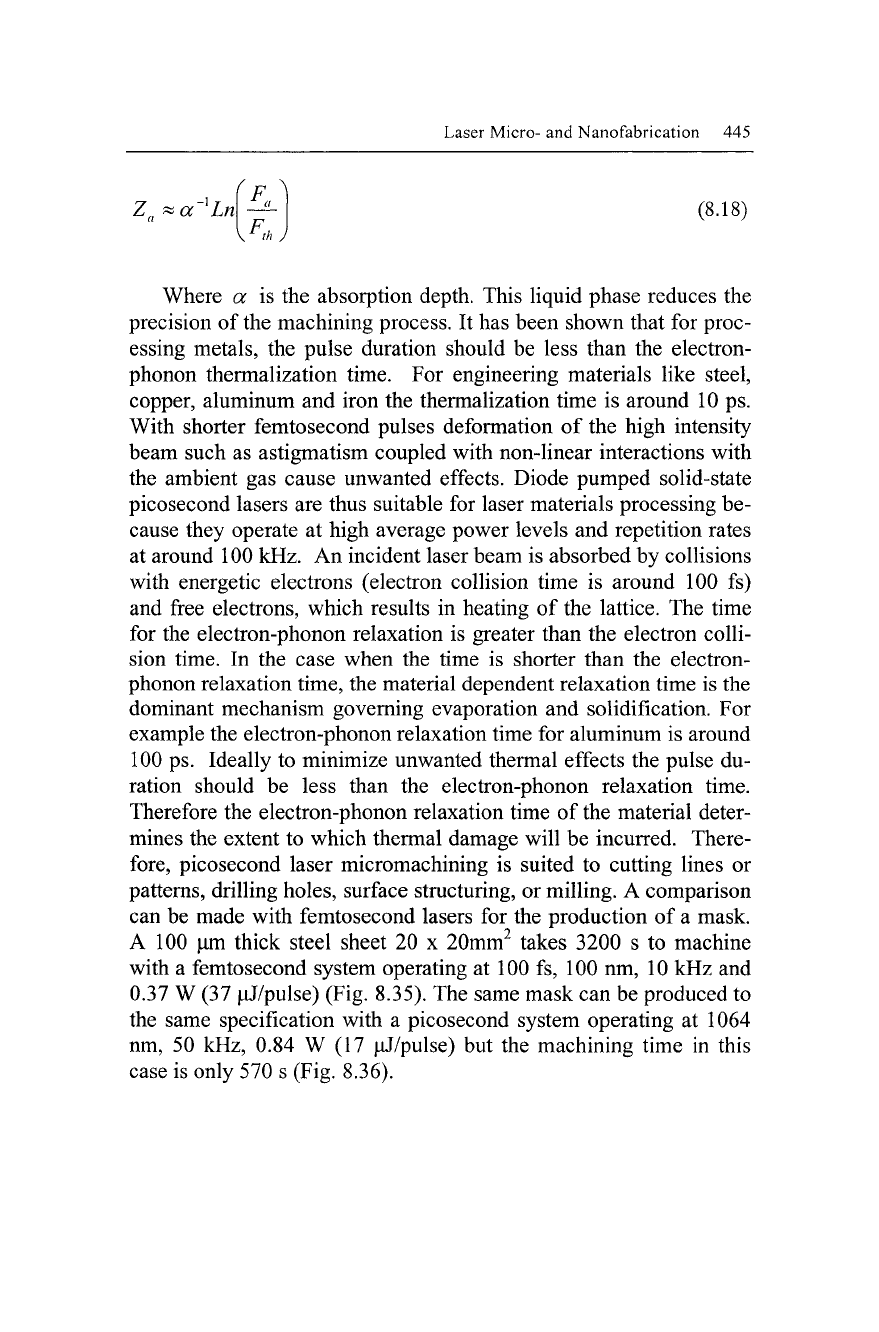
Laser Micro- and Nanofabrication 445
Z, «ar
^Lm
^F..^
. F .
(8.18)
Where a is the absorption depth. This hquid phase reduces the
precision of the machining process. It has been shown that for proc-
essing metals, the pulse duration should be less than the electron-
phonon thermalization time. For engineering materials like steel,
copper, aluminum and iron the thermalization time is around 10 ps.
With shorter femtosecond pulses deformation of the high intensity
beam such as astigmatism coupled with non-linear interactions with
the ambient gas cause unwanted effects. Diode pumped solid-state
picosecond lasers are thus suitable for laser materials processing be-
cause they operate at high average power levels and repetition rates
at around 100 kHz. An incident laser beam is absorbed by collisions
with energetic electrons (electron collision time is around 100 fs)
and free electrons, which results in heating of the lattice. The time
for the electron-phonon relaxation is greater than the electron colli-
sion time. In the case when the time is shorter than the electron-
phonon relaxation time, the material dependent relaxation time is the
dominant mechanism governing evaporation and solidification. For
example the electron-phonon relaxation time for aluminum is around
100 ps. Ideally to minimize unwanted thermal effects the pulse du-
ration should be less than the electron-phonon relaxation time.
Therefore the electron-phonon relaxation time of the material deter-
mines the extent to which thermal damage will be incurred. There-
fore,
picosecond laser micromachining is suited to cutting lines or
patterns, drilling holes, surface structuring, or milling. A comparison
can be made with femtosecond lasers for the production of a mask.
A 100 |Lim thick steel sheet 20 x 20mm^ takes 3200 s to machine
with a femtosecond system operating at 100 fs, 100 nm, 10 kHz and
0.37 W (37 |iJ/pulse) (Fig. 8.35). The same mask can be produced to
the same specification with a picosecond system operating at 1064
nm, 50 kHz, 0.84 W (17 jiJ/pulse) but the machining time in this
case is only 570 s (Fig. 8.36).
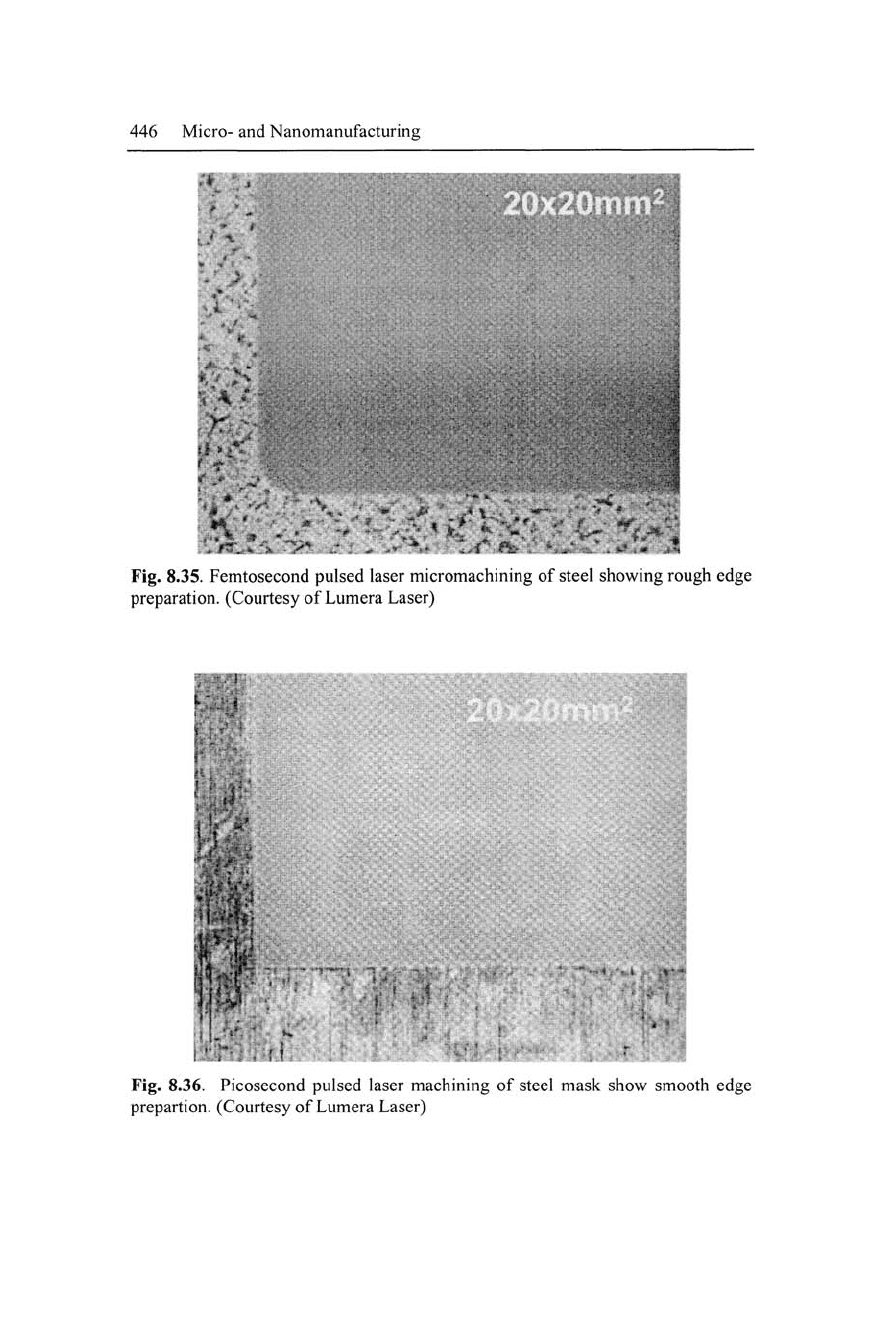
446 Micro- and Nanomanufacturing
Fig. 8.35. Femtosecond pulsed laser micromachining of steel showing rough edge
preparation. (Courtesy of Lumera Laser)
Fig. 8.36. Picosecond pulsed laser machining of steel mask show smooth edge
prepartion. (Courtesy of Lumera Laser)
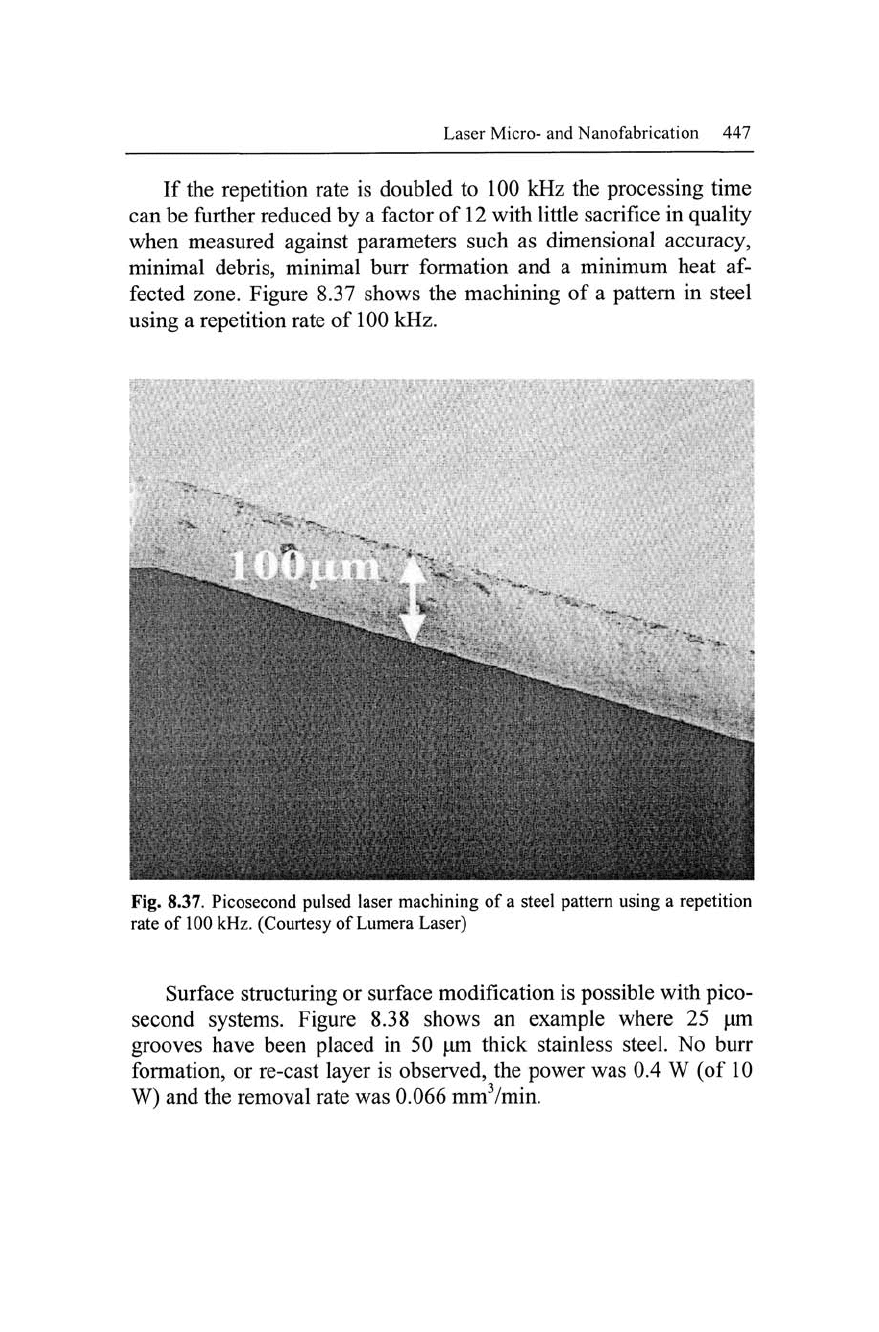
Laser Micro- and Nanofabrication 447
If the repetition rate is doubled to 100 kHz the processing time
can be further reduced by a factor of 12 with little sacrifice in quality
when measured against parameters such as dimensional accuracy,
minimal debris, minimal burr formation and a minimum heat af-
fected zone. Figure 8.37 shows the machining of a pattern in steel
using a repetition rate of 100 kHz.
Fig. 8.37. Picosecond pulsed laser machining of a steel pattern using a repetition
rate of 100 kHz. (Courtesy of Lumera Laser)
Surface structuring or surface modification is possible with pico-
second systems. Figure 8.38 shows an example where 25 |Lim
grooves have been placed in 50 |Lim thick stainless steel. No burr
formation, or re-cast layer is observed, the power was 0.4 W (of 10
W) and the removal rate was 0.066 mm'^/min.
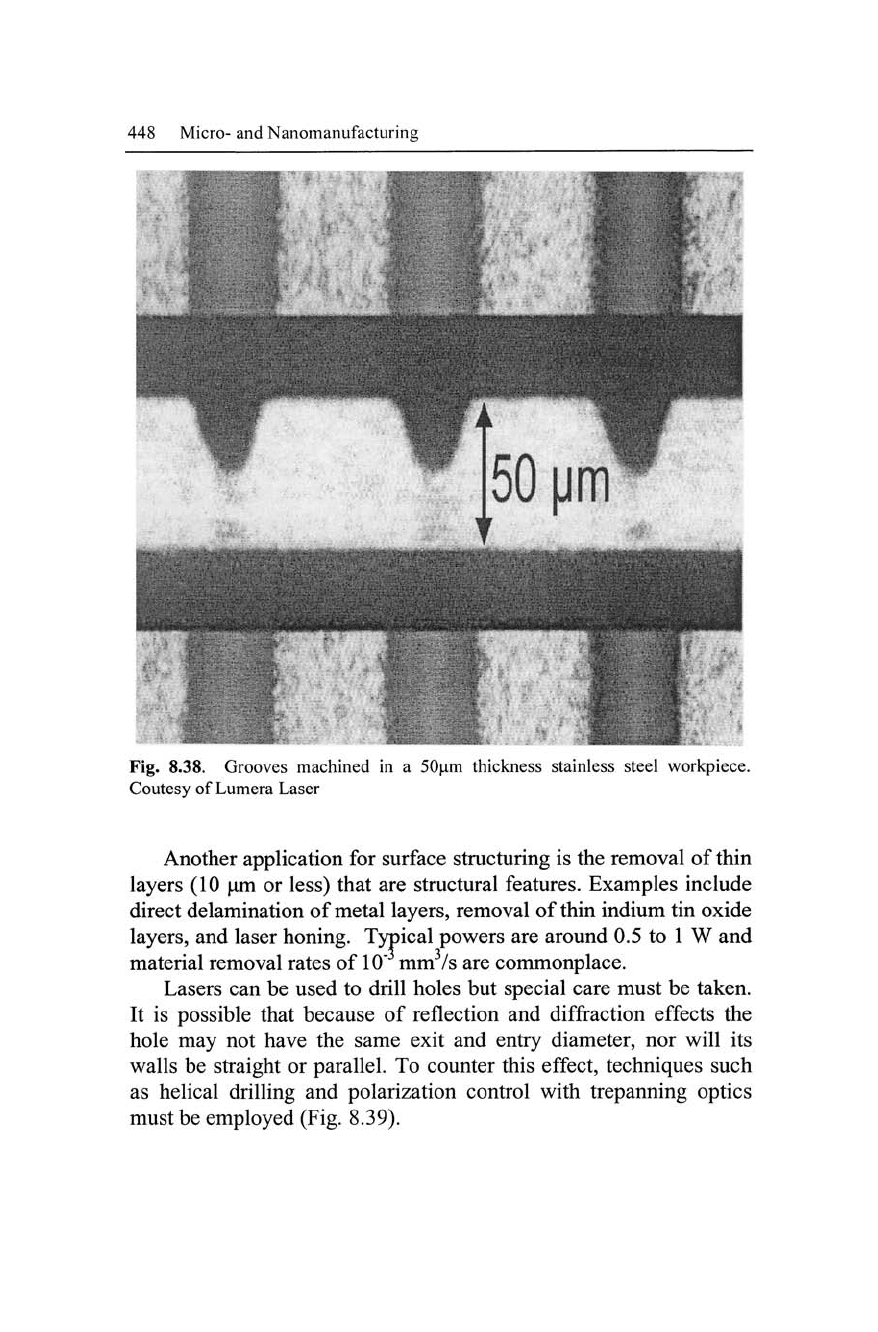
448 Micro- and Nanomanufacturing
Fig. 8.38. Grooves machined in a 50|am thickness stainless steel workpiece.
Coutesy of Lumera Laser
Another application for surface structuring is the removal of thin
layers (10 |xm or less) that are structural features. Examples include
direct delamination of metal layers, removal of thin indium tin oxide
layers, and laser honing. Typical powers are around 0.5 to 1 W and
material removal rates of
10"
mm^/s are commonplace.
Lasers can be used to drill holes but special care must be taken.
It is possible that because of reflection and diffraction effects the
hole may not have the same exit and entry diameter, nor will its
walls be straight or parallel. To counter this effect, techniques such
as helical drilling and polarization control with trepanning optics
must be employed (Fig. 8.39).
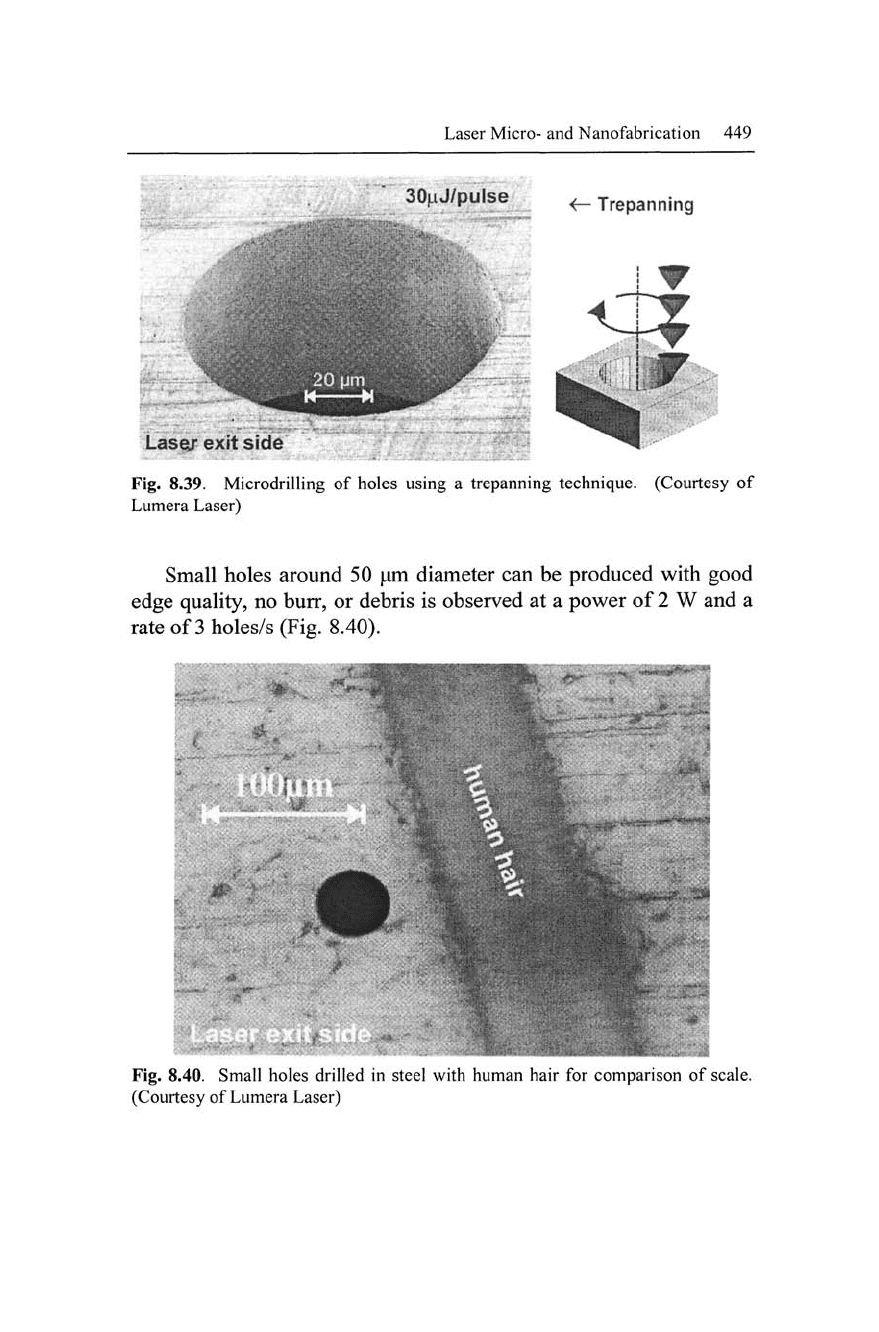
Laser Micro- and Nanofabrication 449
30^J/pulse ^Trepanning
Las^
exit side
Fig. 8.39. Microdrilling of holes using a trepanning technique. (Courtesy of
Lumera Laser)
Small holes around 50 |Lim diameter can be produced with good
edge quality, no burr, or debris is observed at a power of 2 W and a
rate of
3
holes/s (Fig. 8.40).
Fig. 8.40. Small holes drilled in steel with human hair for comparison of scale.
(Courtesy of Lumera Laser)
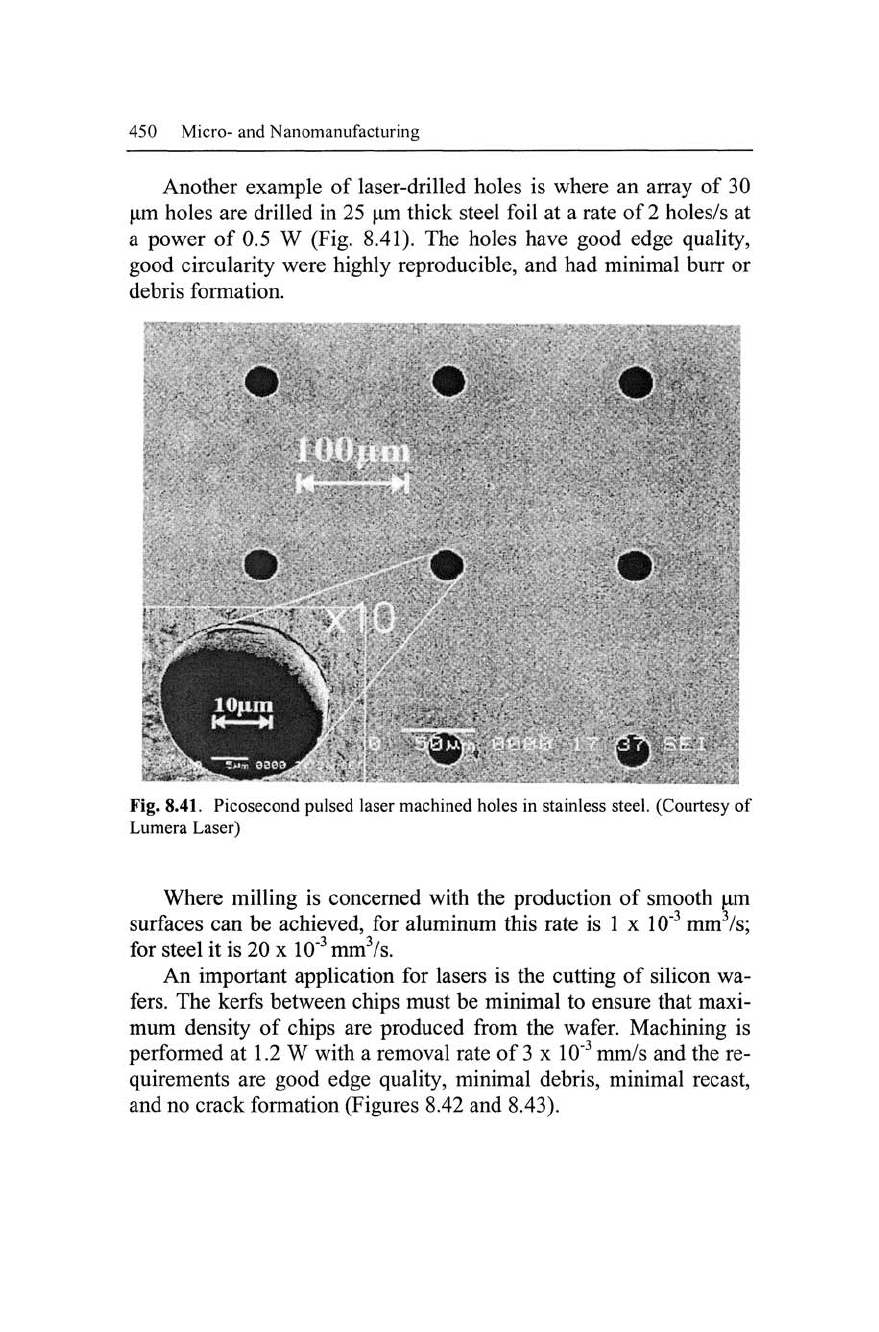
450 Micro- and Nanomanufacturing
Another example of laser-drilled holes is where an array of 30
|Lim holes are drilled in 25 jam thick steel foil at a rate of
2
holes/s at
a power of 0.5 W (Fig. 8.41). The holes have good edge quality,
good circularity were highly reproducible, and had minimal burr or
debris formation.
Fig. 8.41. Picosecond pulsed laser machined holes in stainless steel. (Courtesy of
Lumera Laser)
Where milling is concerned with the production of smooth |im
surfaces can be achieved, for aluminum this rate is 1 x 10'^ mm^/s;
for steel it is 20 x
10"^
mmVs.
An important application for lasers is the cutting of silicon wa-
fers.
The kerfs between chips must be minimal to ensure that maxi-
mum density of chips are produced from the wafer. Machining is
performed at 1.2 W with a removal rate of
3
x
10""^
mm/s and the re-
quirements are good edge quality, minimal debris, minimal recast,
and no crack formation (Figures 8.42 and 8.43).
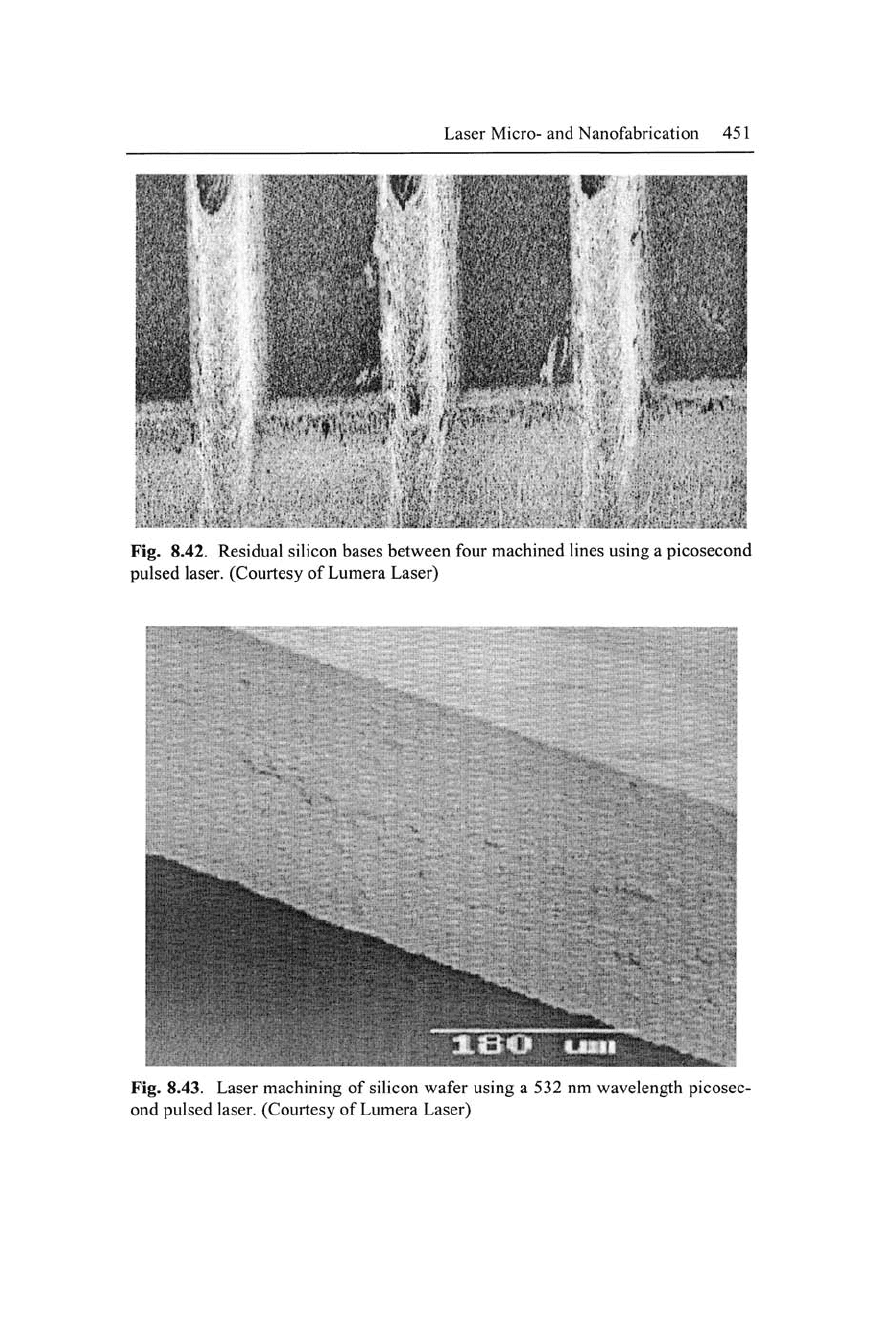
Laser Micro- and Nanofabrication 451
fSS'W
I
*•;
K.lpl^'^tWM'KTKt'Sl^^jmti.
•'"'":":/S
Fig. 8.42. Residual silicon bases between four machined lines using a picosecond
pulsed laser. (Courtesy of Lumera Laser)
Fig. 8.43. Laser machining of silicon wafer using a 532 nm wavelength picosec-
ond pulsed laser. (Courtesy of Lumera Laser)
